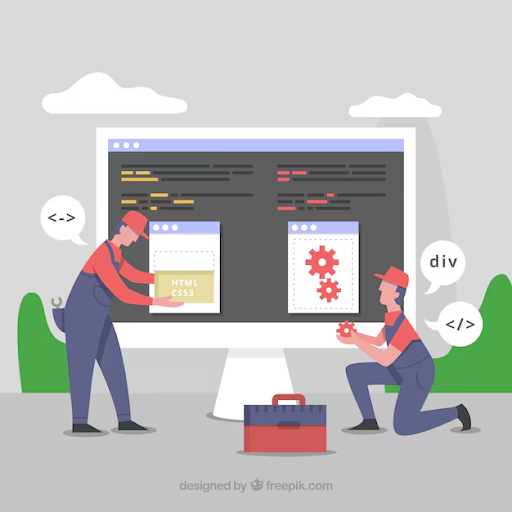With the rise of AI and no-code web development, it is understandable to question is backend engineering dying. However, answering this question is not so simple. Some believe with AI taking over various fields, backend engineering is becoming obsolete, but others believe its demand is still the same, if not more.
So, let’s get into the details of backend engineering’s current status and try to uncover the truth about its future.
What is Backend Engineering
Backend engineering focuses on building and maintaining the server-side logic, databases, and APIs that power applications. While the front end is what users interact with, the back end ensures the functionality and performance of applications by managing data, handling business logic, and ensuring security.
Key responsibilities of a backend engineer include:
- Designing database schemas and maintaining data integrity.
- Building APIs to enable communication between frontend and backend systems.
- Implementing server-side logic and business processes.
- Ensuring application scalability, reliability, and performance.
- Integrating third-party services or tools.
Is Backend Engineering Dying?
The short answer is no. However, there are reasons why this question arises:
- Rise of No-Code/Low-Code Platforms
No-code and low-code platforms have simplified the process of creating applications by abstracting much of the backend complexity. Tools like Firebase, Bubble, and Zapier allow businesses to build applications without needing dedicated backend engineers.
Though these tools are great for small projects, they can’t offer scalability, flexibility, and customization. For enterprise-grade applications or those requiring advanced functionality, skilled backend engineers remain indispensable.
- Serverless Architectures
Serverless computing, offered by providers like AWS Lambda and Azure Functions, has reduced the need for developers to manage infrastructure. Some argue this diminishes the role of backend engineers, but in reality, it shifts their focus to:
- Designing event-driven architectures
- Optimizing cloud services
- Ensuring seamless integrations
- API-First Ecosystem
The proliferation of pre-built APIs for payment processing, authentication, and other common functionalities might give the impression that backend work is declining. However, integrating and managing these APIs, along with building custom APIs, still requires backend expertise.
- Misconception About Frontend Dominance
The surge in popularity of frontend frameworks like React, Vue.js, and Angular often overshadows backend work. However, they can only operate fine if they have a strong backend supporting them.
Future of Backend Development
The future of backend development is far from bleak. In fact, backend engineering is evolving to meet modern demands and trends. Here are some key directions:
- Cloud-Native Development
Cloud computing continues to revolutionize how applications are developed and deployed. Backend engineers increasingly focus on designing systems optimized for cloud environments, leveraging containerization (e.g., Docker, Kubernetes) and microservices.
- Focus on Scalability and Resilience
With larger and more diverse user bases of applications, backend engineers prioritize scalability and fault tolerance. Distributed systems, database sharding, and advanced caching strategies are becoming important.
- AI and Machine Learning Integration
Backend systems often handle the data pipelines and processing required for AI and machine learning. Engineers with knowledge in these areas are in high demand to introduce intelligent features in modern applications.
- Security and Compliance
With increasing data privacy regulations e.g., GDPR, CCPA, and the growing threat of cyberattacks, backend engineers play a pivotal role in ensuring secure data handling and compliance with legal standards.
- Event-Driven Architectures
Real-time applications are adopting event-driven architectures. Such applications include chat platforms, stock trading apps, and IoT systems. Backend engineers play a key role in implementing message brokers, stream processing, and asynchronous workflows.
- Greater Collaboration with Frontend Teams
The line between frontend and backend roles is blurring, with full-stack development gaining prominence. Backend engineers who understand frontend frameworks and collaborate effectively with designers and frontend developers have a competitive edge.
Demand for Backend Engineers
Despite claims of its decline, the demand for backend engineers remains strong. Various sectors need strong backend systems to continue their digital operations.
Let’s see the reasons behind this demand:
- Digital Transformation
From e-commerce platforms to enterprise websites, businesses are shifting their focus to digitization of their operations. This is where skilled backend engineers are needed to create such efficient systems.
- Custom Solutions
Off-the-shelf solutions or no-code platforms cannot address every business need. Custom backend systems are important for organizations with unique requirements.
- Data-Driven Decision-Making
The surge in big data and analytics means backend systems must handle vast amounts of information. Engineers skilled in database design, data warehousing, and ETL processes are highly sought after.
- Evolving Technologies
Emerging technologies like blockchain, IoT, and edge computing require specialized backend expertise to implement effectively.
According to job market data, roles for backend engineers consistently rank among the top positions in software development, with competitive salaries reflecting the high demand.
Backend Development Trends
To stay relevant, backend engineers need to adapt to the latest trends in the industry. Here are some of the most significant:
- GraphQL Adoption
GraphQL is becoming a popular alternative to REST APIs, offering greater flexibility and efficiency in data fetching. Backend engineers proficient in GraphQL are in demand.
- Infrastructure as Code (IaC)
Tools like Terraform and AWS CloudFormation enable engineers to manage infrastructure programmatically, ensuring consistency and scalability.
- Server-Side Rendering (SSR) and Static Site Generation (SSG)
Frameworks like Next.js and Nuxt.js are driving backend involvement in delivering pre-rendered content for performance and SEO benefits.
- Hybrid and Multi-Cloud Architectures
Organizations are adopting hybrid and multi-cloud strategies to avoid vendor lock-in. Backend engineers must design systems that operate seamlessly across multiple environments.
- API Gateways and Management
For securing, monitoring, and scaling APIs in modern applications API management platforms like Kong, Apigee, and AWS API Gateway are important.
Conclusion
So, is backend engineering dying? Absolutely not. While the field is undergoing significant transformation, backend engineering remains important to the software development ecosystem. We can safely say the future of backend engineering is strong with new opportunities and evolving technology.
Backend engineering is not just alive but thriving in its evolution to meet the demands of modern applications. So, this is it from our side. For more such articles stay connected with Tambena Consulting. Also, if you need any kind of technical assistance and services feel free to contact us anytime.
FAQs
Is there still a demand for backend developers?
As businesses continue to build complex, scalable systems and applications, there is a strong demand for backend developers.
How is serverless computing impacting backend development?
Serverless computing simplifies backend development by eliminating server management, reducing costs, and enabling faster deployment and scalability.
What skills are essential for a backend developer in 2025?
Essential skills include proficiency in languages like Python, Java, or Go, API design, databases, cloud platforms, and security practices.
How does AI influence backend development?
AI enhances backend development through automation, optimizing code, improving performance, enabling intelligent analytics, and streamlining decision-making processes.
Is front-end development overtaking back-end development?
Both front-end and back-end development are equally essential, with growing demand for full-stack developers bridging both areas.






